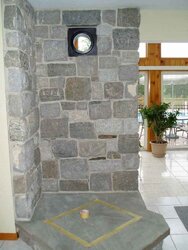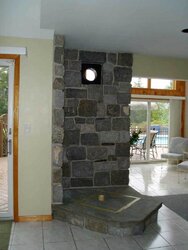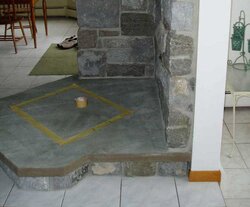I have designed and have had constructed a stone hearth for a PE T6, to be professionally installed next week. After laying my template inline with the thimble on the hearth wall, it appears the PE T6 will reside on the hearthstone as I designed, with 6-7" corner clearances and centering on the hearthstone. The wall thimble was installed, than the bluestone hearthstone, granite and dolomitic limestone on the walls.
The only issue, and have not seen it discussed in this forum, is the ability to adjust the length of a horizontal run of the DVL stovepipe... connecting to the Class A pipe to transition the thimble. I am worried that the position (distance) of the T6 from the wall/thimble will be determined by the sections of DVL pipe 6/12/24/36" and its connections. And not where I have the template placed on the hearthstone. Would using multiple 6" of DVL allow for fudging the total length to fit where I designed the stove to rest?
The question is, how much give and take in length, can be made during the assembly of the pieces of DVL pipe. And/Or can a adjustable length of DVL be used in a horizontal run?
Images attached to possibly help: the roll of duct tape represents the T6 stovepipe connector centered 8.5" from the back wall of the T6. Masking tape on bluestone is my designed and hopeful resting area for the T6. Horizontal distance from T6 to thimble is ~ 30". Then 2 stories of class a thru ceiling and roof.
Thanks for all the information and experiences that is shared in the hearth.com forums.
The only issue, and have not seen it discussed in this forum, is the ability to adjust the length of a horizontal run of the DVL stovepipe... connecting to the Class A pipe to transition the thimble. I am worried that the position (distance) of the T6 from the wall/thimble will be determined by the sections of DVL pipe 6/12/24/36" and its connections. And not where I have the template placed on the hearthstone. Would using multiple 6" of DVL allow for fudging the total length to fit where I designed the stove to rest?
The question is, how much give and take in length, can be made during the assembly of the pieces of DVL pipe. And/Or can a adjustable length of DVL be used in a horizontal run?
Images attached to possibly help: the roll of duct tape represents the T6 stovepipe connector centered 8.5" from the back wall of the T6. Masking tape on bluestone is my designed and hopeful resting area for the T6. Horizontal distance from T6 to thimble is ~ 30". Then 2 stories of class a thru ceiling and roof.
Thanks for all the information and experiences that is shared in the hearth.com forums.




